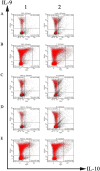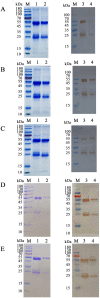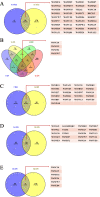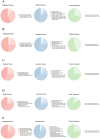Identification of excretory and secretory proteins from Haemonchus contortus inducing a Th9 immune response in goats
- PMID: 35597967
- PMCID: PMC9123704
- DOI: 10.1186/s13567-022-01055-8
Identification of excretory and secretory proteins from Haemonchus contortus inducing a Th9 immune response in goats
Abstract
Th9 cells have been shown to play crucial roles in anti-parasite immunity, pathogenic microbe infection, and allergy. Previous studies have demonstrated that Haemonchus contortus excretory and secretory proteins (HcESPs) induce the proliferation of Th9 cells and alter the transcriptional level of IL-9 as well as its related pathways in the Th9 immune response after infection. However, the exact molecule(s) in HcESPs inducing the Th9 immune response is not yet known. In this study, flow cytometry, co-immunoprecipitation (Co-IP) and shotgun liquid chromatography tandem-mass spectrometry (LC-MS/MS) were used, and a total of 218 proteins from HcESPs that might interact with goat Th9 cells were identified. By in vitro culture of Th9 cells with HcESPs, 40 binding proteins were identified. In vivo, 38, 47, 42 and 142 binding proteins were identified at 7, 15, 35 and 50 days post-infection (dpi), respectively. Furthermore, 2 of the 218 HcESPs, named DNA/RNA helicase domain containing protein (HcDR) and GATA transcription factor (HcGATA), were confirmed to induce the proliferation of Th9 cells and promote the expression of IL-9 when incubated with goat peripheral blood mononuclear cells (PBMCs). This study represents a proteomics-guided investigation of the interactions between Th9 cells and HcESPs. It provides a new way to explore immunostimulatory antigens among HcESPs and identifies candidates for immune-mediated prevention of H. contortus infection.
Keywords: Haemonchus contortus; HcDR; HcGATA; Th9 immune response; binding molecules; proteomics.
© 2022. The Author(s).
Conflict of interest statement
The authors declare that they have no competing interests.
Figures







Similar articles
-
Haemonchus contortus HcL6 promoted the Th9 immune response in goat PBMCs by activating the STAT6/PU.1/NF-κB pathway.Vet Res. 2023 Sep 22;54(1):80. doi: 10.1186/s13567-023-01214-5. Vet Res. 2023. PMID: 37740213 Free PMC article.
-
Immunomodulatory dynamics of excretory and secretory products on Th9 immune response during Haemonchus contortus infection in goat.PLoS Negl Trop Dis. 2020 Apr 3;14(4):e0008218. doi: 10.1371/journal.pntd.0008218. eCollection 2020 Apr. PLoS Negl Trop Dis. 2020. PMID: 32243446 Free PMC article.
-
Haemonchus contortus excretory and secretory proteins (HcESPs) suppress functions of goat PBMCs in vitro.Oncotarget. 2016 Jun 14;7(24):35670-35679. doi: 10.18632/oncotarget.9589. Oncotarget. 2016. PMID: 27229536 Free PMC article.
-
A Comprehensive Review on Haemonchus contortus Excretory and Secretory Proteins (HcESPs): TH-9 stimulated ESPs as a potential candidate for Vaccine Development and Diagnostic Antigen.Acta Trop. 2024 Dec;260:107462. doi: 10.1016/j.actatropica.2024.107462. Epub 2024 Nov 10. Acta Trop. 2024. PMID: 39527996 Review.
-
The Identification of Haemonchus Species and Diagnosis of Haemonchosis.Adv Parasitol. 2016;93:145-80. doi: 10.1016/bs.apar.2016.02.023. Epub 2016 Mar 31. Adv Parasitol. 2016. PMID: 27238005 Review.
Cited by
-
Haemonchus contortus HcL6 promoted the Th9 immune response in goat PBMCs by activating the STAT6/PU.1/NF-κB pathway.Vet Res. 2023 Sep 22;54(1):80. doi: 10.1186/s13567-023-01214-5. Vet Res. 2023. PMID: 37740213 Free PMC article.
-
Quantitative proteomics reveals significant variation in host responses of cattle with differing buffalo fly susceptibility.Front Immunol. 2024 Jul 16;15:1402123. doi: 10.3389/fimmu.2024.1402123. eCollection 2024. Front Immunol. 2024. PMID: 39086482 Free PMC article.
-
An Overview of Advancements in Proteomic Approaches to Enhance Livestock Production and Aquaculture.Animals (Basel). 2025 Jul 2;15(13):1946. doi: 10.3390/ani15131946. Animals (Basel). 2025. PMID: 40646845 Free PMC article. Review.
-
Comparative proteomics analysis of adult Haemonchus contortus isolates from Ovis ammon.Front Cell Infect Microbiol. 2023 Mar 16;13:1087210. doi: 10.3389/fcimb.2023.1087210. eCollection 2023. Front Cell Infect Microbiol. 2023. PMID: 37009511 Free PMC article.
-
In vitro culture of the parasitic stage larvae of hematophagous parasitic nematode Haemonchus contortus.Int J Parasitol. 2025 Apr;55(5):263-271. doi: 10.1016/j.ijpara.2025.01.007. Epub 2025 Jan 21. Int J Parasitol. 2025. PMID: 39848307 Free PMC article.
References
-
- Kaplan RM, Vidyashankar AN. An inconvenient truth: global worming and anthelmintic resistance. Vet Parasitol. 2012;186:70–78. - PubMed
-
- Geurden T, Chartier C, Fanke J, di Regalbono AF, Traversa D, von Samson-Himmelstjerna G, Demeler J, Vanimisetti HB, Bartram DJ, Denwood MJ. Anthelmintic resistance to ivermectin and moxidectin in gastrointestinal nematodes of cattle in Europe. Int J Parasitol Drugs Drug Resist. 2015;5:163–1714. - PMC - PubMed
-
- Hu Y, Cheng H. Health risk from veterinary antimicrobial use in China’s food animal production and its reduction. Environ Pollut. 2016;219:993–997. - PubMed
-
- Nisbet AJ, Meeusen EN, González JF, Piedrafita DM. Immunity to Haemonchus contortus and vaccine development. Adv Parasitol. 2016;93:353–396. - PubMed
MeSH terms
Substances
Grants and funding
LinkOut - more resources
Full Text Sources

